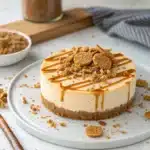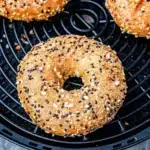Whipped Honey Butter is one of those simple pleasures that can instantly transform everyday bread, muffins, or pancakes into something extraordinary. With its light, fluffy texture and a perfect balance of sweet and buttery richness, it’s no wonder this spread is a favorite in homes and bakeries alike. In this guide, we’ll cover everything from the basics of what whipped honey butter is, to step-by-step recipes, creative flavor variations, storage tips, and expert baker advice. You’ll even learn how to pair it with your favorite treats for a restaurant-quality experience at home. Learn more about baking with honey in our Honey Cookies recipe.

Table of Contents
Understanding Whipped Honey Butter
What is Whipped Honey Butter and Why It’s Loved by Bakers
At its core, whipped honey butter is a smooth, airy spread made by combining softened butter with pure honey, whipped together until light and fluffy. This process not only blends the flavors beautifully but also incorporates air, giving it that cloud-like texture that melts effortlessly on warm bread or pastries. Unlike simple honey butter, which can be dense and heavy, whipped honey butter is lighter and spreads more easily, making it perfect for breakfast tables, brunch menus, and special occasions.
Bakers love it because it enhances baked goods without overpowering them. Its sweetness comes entirely from natural honey, which means you get a rich, nuanced flavor profile with floral and caramel notes, depending on the type of honey used. Plus, the creaminess adds a decadent touch that makes even simple toast taste indulgent.

Whipped Honey Butter
- Total Time: 10 minutes
- Yield: 1 ½ cups 1x
Description
A light, fluffy spread that combines rich butter with sweet honey—perfect for elevating breads, muffins, and pancakes.
Ingredients
- 1 cup (2 sticks) unsalted butter, softened
- ⅓ cup raw honey (adjust to taste)
- Pinch of fine sea salt (optional)
Instructions
- Let butter sit at room temperature until soft.
- Whip butter on medium-high speed for 2–3 minutes until pale and fluffy.
- Slowly pour in honey while whipping. Increase speed to high and beat for 2–3 minutes.
- Add a pinch of salt if desired, and whip for 30 more seconds.
- Transfer to airtight container. Store at room temperature for 2 days or refrigerate up to 2 weeks.
Notes
For extra fluffiness, whip butter alone until nearly white before adding honey. Bring refrigerated butter to room temperature before serving for best texture.
- Prep Time: 10 minutes
- Cook Time: 0 minutes
- Category: Spread
- Method: No-Cook
- Cuisine: American
Nutrition
- Serving Size: 1 tablespoon
- Calories: 95
- Sugar: 6g
- Sodium: 10mg
- Fat: 8g
- Saturated Fat: 5g
- Unsaturated Fat: 3g
- Trans Fat: 0g
- Carbohydrates: 7g
- Fiber: 0g
- Protein: 0g
- Cholesterol: 20mg
The History of Whipped Honey Butter in Culinary Traditions
While the exact origins of whipped honey butter are hard to pinpoint, sweetened butter spreads have been a part of culinary traditions for centuries. In European kitchens, flavored butters—often called compound butters—were common for both savory and sweet applications. Honey butter, in particular, was popular in rural areas where fresh dairy and honey were readily available.
The whipped version we know today likely evolved as stand mixers and electric beaters became household staples in the 20th century. This technology allowed for the airy texture that has made whipped honey butter a brunch favorite in cafés and hotels around the world. In modern cooking, it’s not just a spread but also a finishing touch for desserts, roasted vegetables, and even grilled meats, giving dishes a subtle glaze and sweetness.
Ingredients for Whipped Honey Butter

Choosing the Best Butter for Creamy Whipped Honey Butter
The quality of your butter plays a major role in the final taste and texture of your whipped honey butter. Always start with unsalted, high-fat butter—ideally 82% milk fat or higher—for a rich, creamy base. European-style butters, like Kerrygold or Plugrá, are popular choices because they have less water and more flavor.
For the best results, the butter should be at room temperature before whipping. Cold butter won’t incorporate air as easily, resulting in a dense spread. Avoid overly processed or margarine-based products, as they can alter both texture and flavor. If you prefer a subtle tang, try using cultured butter, which is made with fermented cream for a slightly more complex taste profile.
Selecting the Perfect Honey for Optimal Flavor
The honey you choose will define the sweetness and depth of your whipped honey butter. While any pure, raw honey will work, the variety can drastically influence the flavor. Clover honey delivers a mild sweetness perfect for everyday use, while wildflower honey offers floral complexity. For a bolder, almost caramel-like taste, opt for buckwheat honey.
Whenever possible, select raw, unfiltered honey for maximum flavor and health benefits, since it retains natural enzymes, antioxidants, and pollen. Processed honey can be overly sweet and one-dimensional. If you want a unique twist, experiment with infused honeys like cinnamon, lavender, or chili for subtle yet intriguing undertones.
Tip: Store your honey in a cool, dry place and avoid refrigerating it, as cold temperatures can cause crystallization, which may affect the smoothness of your whipped honey butter.
How to Make Whipped Honey Butter at Home
Step-by-Step Recipe for Classic Whipped Honey Butter
Making whipped honey butter is quick, easy, and requires just a few simple ingredients. Here’s a foolproof method to achieve that light, airy texture every time:
Ingredients:
- 1 cup (2 sticks) unsalted butter, softened
- ⅓ cup raw honey (adjust to taste)
- Pinch of fine sea salt (optional, to balance sweetness)
Instructions:
- Prepare your butter – Let the butter sit at room temperature until it’s soft enough to press with your finger without resistance.
- Start whipping – In a stand mixer fitted with the whisk attachment, or using a handheld mixer, whip the softened butter on medium-high speed for 2–3 minutes until pale and fluffy.
- Add the honey – Pour in the honey slowly while continuing to whip. Increase the speed to high and beat for another 2–3 minutes until the mixture is fully incorporated and light in texture.
- Taste and adjust – Add more honey for extra sweetness or a pinch of salt to enhance the flavors. Whip for another 30 seconds.
- Store properly – Transfer the whipped honey butter to an airtight container. Keep it at room temperature for up to 2 days, or refrigerate for up to 2 weeks. Allow it to come to room temperature before serving to achieve the lightest, fluffiest texture.
Pro Tip: For an even silkier texture, whip the butter alone first until it’s nearly white before adding the honey. This ensures maximum aeration.
Learn more about making sweet spreads in our Honey Cookies recipe for another delicious way to enjoy honey in baking.

Common Mistakes to Avoid When Whipping Butter and Honey
Even though the recipe is simple, a few common errors can affect your results:
- Using cold butter – This prevents proper aeration, leading to a dense spread.
- Over-whipping – While you want it airy, too much whipping can cause the butter to split, releasing liquid and ruining the texture.
- Adding cold honey – If your honey has been refrigerated, bring it to room temperature first. Cold honey can harden butter during whipping.
- Skipping the salt – Even in sweet spreads, a small pinch of salt enhances overall flavor and balances the sweetness.
Flavor Variations of Whipped Honey Butter
Adding Spices and Herbs for a Gourmet Twist
One of the best things about whipped honey butter is how versatile it is. By adding a few simple ingredients, you can customize variations to fit any event perfectly. Adding spices like cinnamon, nutmeg, or pumpkin pie spice transforms your spread into a cozy, autumn-inspired treat. Add a pinch of ground ginger or cardamom for a warm, flavorful depth.
Fresh herbs can also create a stunning flavor profile. Whipped honey butter with finely chopped rosemary pairs beautifully with warm dinner rolls, while thyme brings a subtle earthiness that complements roasted vegetables. For an unexpected yet delightful combination, blend in a hint of crushed lavender buds for a fragrant floral note.
When adding spices or herbs, whip them in at the same time as the honey to ensure they’re evenly distributed throughout the spread.
Infusing Whipped Honey Butter with Fruits and Nuts
Fruit and nut additions can make whipped honey butter a showstopper for brunch tables and holiday spreads. Fold in finely diced dried fruits like apricots, cranberries, or figs for bursts of sweetness and color. Toasted nuts such as pecans, walnuts, or almonds add crunch and a rich, nutty undertone.
For a naturally fruity flavor without altering the texture too much, try blending in freeze-dried fruit powder, such as strawberry or raspberry. This not only boosts flavor but also gives the butter a gorgeous hue that’s perfect for special presentations.
You can even experiment with citrus zest—lemon, orange, or lime—to create a refreshing, tangy counterpoint to the honey’s sweetness.
Discover great ideas like our Honey Bun Cake for another sweet, honey-based treat that pairs perfectly with a flavored butter spread.
Serving Ideas for Whipped Honey Butter
Perfect Pairings with Breads, Muffins, and Pancakes
Whipped honey butter is at its best when paired with fresh-baked goods. Spread it generously over warm sourdough slices, flaky croissants, or crusty baguettes for a bakery-quality snack. It’s a perfect companion for muffins, scones, and biscuits—melting into every crumb to create a sweet, buttery finish.
For breakfast lovers, whipped honey butter takes pancakes, waffles, and French toast to the next level. The heat from these dishes softens the butter instantly, creating a glossy glaze that seeps into every bite. Cornbread is another perfect match, with the honey butter balancing its slightly savory notes.
Creative Ways to Use Whipped Honey Butter in Recipes
This spread isn’t just for bread—it’s a versatile ingredient in both sweet and savory recipes. Use it as a glaze for roasted root vegetables, like carrots or sweet potatoes, for a caramelized finish. It’s also excellent melted over grilled peaches or pineapple for a quick dessert.
In baking, substitute whipped honey butter for regular butter in cookie or cake recipes to add natural sweetness and complexity. It can also be swirled into oatmeal, dolloped onto baked sweet potatoes, or melted over fresh popcorn for a gourmet snack.
For a fun appetizer, spread whipped honey butter over crackers and top with brie or blue cheese. The blend of sweet, salty, and creamy flavors creates an unforgettable experience.
Check out this sweet treat inspiration in our Raspberry Muffins with Crumb Topping for another delicious pairing idea.
Storage and Shelf Life of Whipped Honey Butter
Best Practices for Refrigerating and Freezing
Proper storage is key to keeping your whipped honey butter fresh, flavorful, and safe to eat. If you plan to use it within a few days, you can store it at room temperature in an airtight container, away from direct sunlight and heat sources. This keeps the butter soft and spreadable without affecting its taste.
For longer storage, refrigerate the whipped honey butter in a sealed container. It will firm up in the cold, so remember to bring it back to room temperature before serving for the fluffiest texture. Whipped honey butter can last up to 2 weeks in the refrigerator.
Freezing is another excellent option if you’ve made a large batch. Portion it into small airtight containers or wrap it tightly in plastic wrap and then foil to prevent freezer burn. Frozen whipped honey butter can last for up to three months. Thaw in the refrigerator overnight, then let it sit out for 30–60 minutes before serving.
Signs Your Whipped Honey Butter Has Gone Bad
While whipped honey butter is generally stable thanks to honey’s natural antibacterial properties, it can still spoil if stored improperly. Watch for these signs:
- Sour or rancid smell – Indicates the butter fat has gone bad.
- Discoloration – A darker or uneven color can mean oxidation or bacterial growth.
- Off taste – Any bitterness or sourness suggests spoilage.
- Mold growth – Rare but possible if moisture gets into the container.
If you notice any of these, discard the butter immediately to avoid foodborne illness.
Nutritional Profile of Whipped Honey Butter
Calories and Macros per Serving
Whipped honey butter is indulgent, but when enjoyed in moderation, it can fit into a balanced diet. On average, one tablespoon (about 14g) contains:
| Nutrient | Amount |
|---|---|
| Calories | ~90–100 kcal |
| Total Fat | 7–8g |
| Saturated Fat | 4–5g |
| Carbohydrates | 5–7g |
| Sugars | 5–6g |
| Protein | 0g |
These values can vary depending on the type of butter and honey you use. Using European-style butter may slightly increase the fat and calorie content, while adding fruit or spices won’t significantly change the macros.
Health Benefits and Considerations
While whipped honey butter is high in calories and saturated fat, it also has a few nutritional benefits when consumed in moderation. Butter delivers fat-soluble vitamins like A, D, E, and K, while honey provides antioxidants and essential trace minerals such as potassium and magnesium.
The natural sugars in honey are easier for some people to digest compared to refined sugar, and its antibacterial properties can contribute to overall wellness. However, because it’s calorie-dense and high in saturated fat, portion control is important—especially if you’re watching your cholesterol or caloric intake.
For a slightly healthier twist, you can substitute part of the butter with whipped coconut oil, which lowers the saturated fat content while maintaining a creamy texture.
Whipped Honey Butter in Commercial Products
Popular Brands and Where to Buy
If you don’t have time to make whipped honey butter at home, there are plenty of ready-made options on the market. Popular grocery brands like Land O’Lakes and Amish Country offer versions that are widely available in supermarkets. These typically come in small tubs or squeezable bottles, making them convenient for quick breakfasts or on-the-go snacks.
Specialty food stores and farmers’ markets are also excellent places to find artisanal whipped honey butter. Local beekeepers often sell unique varieties infused with seasonal flavors, offering freshness and character that mass-produced brands can’t match.
Online retailers such as Amazon, Etsy, and gourmet food sites also carry a wide selection, from classic recipes to creative blends like cinnamon honey butter or lavender honey butter.
How Store-Bought Differs from Homemade Whipped Honey Butter
While commercial whipped honey butter can be delicious, there are notable differences compared to the homemade version. Store-bought varieties often contain stabilizers and preservatives to extend shelf life, which can slightly alter texture and flavor. Some may also include added sweeteners or flavorings, making them sweeter than traditional homemade recipes.
Homemade whipped honey butter, on the other hand, allows you to control every ingredient—from the type of honey to the richness of the butter—and adjust the sweetness to your preference. Plus, making it fresh ensures a lighter, fluffier texture and a more vibrant flavor.
Don’t miss our rich frosting guide in Marshmallow Frosting for another sweet, fluffy topping idea that shares some similarities with whipped honey butter’s texture.
Tips from Expert Bakers on Whipped Honey Butter
Professional Techniques for Extra Fluffiness
Experienced bakers know that the secret to irresistibly light and airy whipped honey butter lies in the whipping process. Always start with room-temperature butter to ensure maximum aeration. Use a stand mixer with a whisk attachment rather than a paddle for the best volume.
Another trick is to whip the butter alone first for 2–3 minutes until it’s pale and creamy before slowly adding honey. Pre-whipping helps build structure, allowing the honey to incorporate seamlessly while maintaining the light, airy texture. If you want an ultra-smooth finish, sift any powdered spices before adding them to avoid clumps.
For a beautiful presentation, transfer the finished butter into a piping bag fitted with a star tip and pipe rosettes onto a serving dish. This not only looks professional but also makes portioning easier.
Troubleshooting Common Problems
Even seasoned bakers encounter issues with whipped honey butter from time to time. Here’s how to fix the most common ones:
- Butter separates – If the mixture looks curdled, it may be too warm. Place the bowl in the fridge for 5–10 minutes, then re-whip.
- Butter is too dense – The butter was likely too cold. Let it sit at room temperature and whip again until light.
- Flavor is too sweet – Add a pinch of salt or a small amount of unsweetened cocoa powder to balance the sweetness.
- Texture is grainy – This can happen if the honey has crystallized. Warm the honey gently before adding it to the butter.
Looking for inspiration? Try our Scones recipe, which pairs beautifully with whipped honey butter for a classic bakery-style treat.
FAQs
Is whipped honey the same as creamed honey?
No, whipped honey and creamed honey are different products. Whipped honey is simply honey that’s been aerated to make it lighter, while creamed honey undergoes a controlled crystallization process to produce a smooth, spreadable consistency without any butter.
What’s the point of whipped honey?
Whipping honey makes it easier to spread and changes the mouthfeel, giving it a smoother texture. When combined with butter, the result is a rich, airy spread that enhances both flavor and presentation.
What is whipped honey made of?
Pure whipped honey is made from 100% honey that has been processed to incorporate air or control crystallization. Whipped honey butter, however, contains both butter and honey, often with optional flavorings like spices or fruit zest.
Conclusion
Whipped honey butter is more than just a sweet spread—it’s a versatile culinary delight that can transform everyday meals into something memorable. Whether you make it at home for brunch, gift it during the holidays, or buy it from your local market, this creamy, airy butter delivers comfort and flavor in every bite. From selecting the perfect honey to mastering the whipping technique, you now have all the tools to create your own variations and serve them in ways that impress.
So next time you bake a loaf of bread or whip up a batch of muffins, remember—there’s nothing quite like pairing them with a dollop of fresh whipped honey butter. Looking for inspiration? Try our Scones for a perfect match.
Fore more recipes follow me in Facebook, medium and Pinterest




